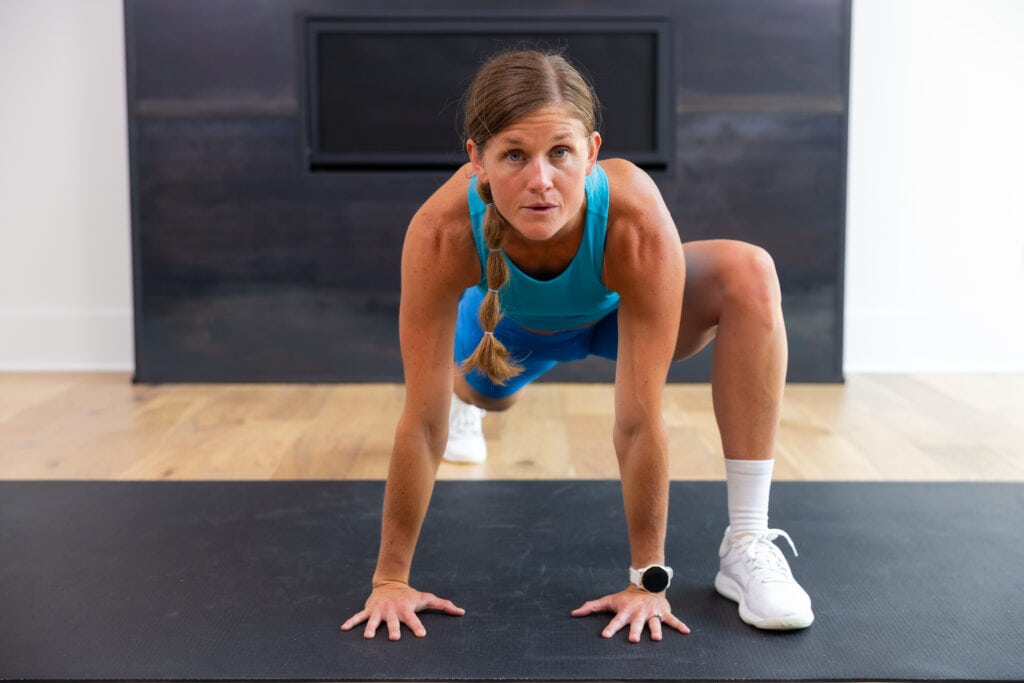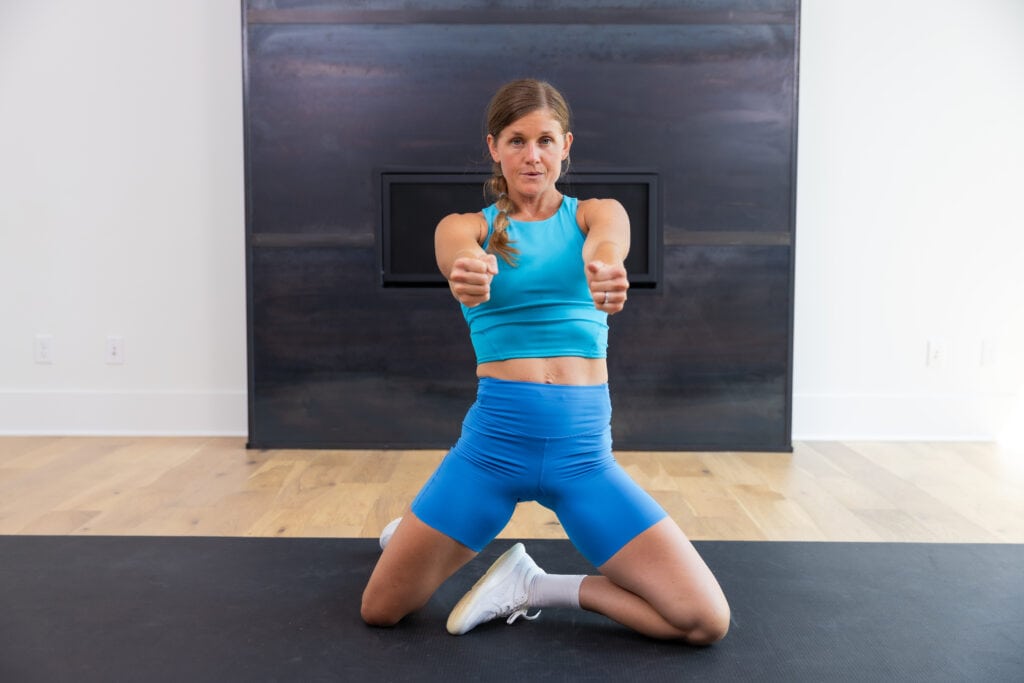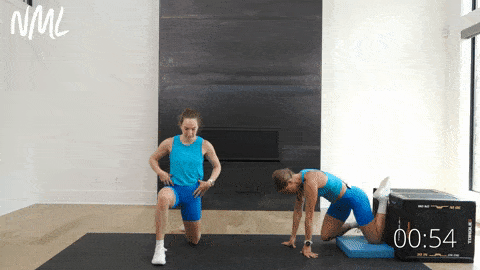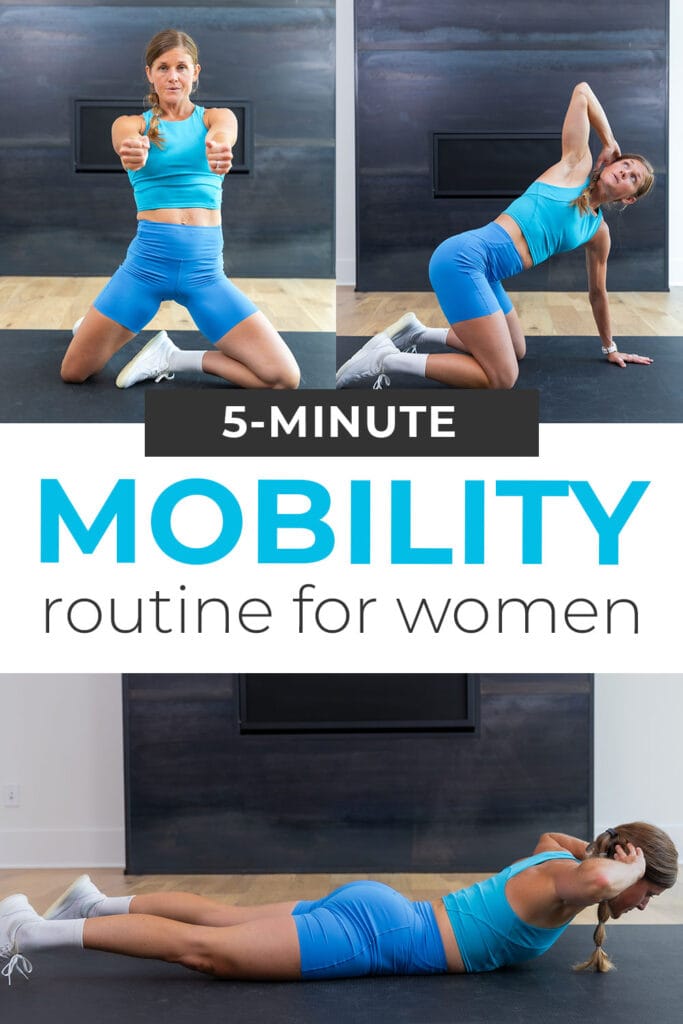 Buy Now →
Buy Now → 

Maintain healthy joints and muscles with these daily mobility exercises. These are the best mobility exercises to protect your joints, increase range of motion, and improve your workouts. This mobility routine targets the hips, shoulders, inner and outer thighs, glutes, chest and back muscles.
Mobility exercises challenge the entire range of motion of a joint, so they’re one of the best things you can do to improve your workouts.
By taking your joints through a full range of motion, mobility training protects and maintains healthy joints, prevents injury, and allows you to move pain-free.
Adding mobility workouts to your routine can also improve your performance in strength training and HIIT workouts. For example, ankle mobility exercises can improve your squat form.
I suggest adding these exercises to your routine daily to improve mobility in the upper body, lower body and spine.

Mobility exercises challenge the entire range of motion of a joint. Consider the dynamic exercises you do in a warm up to prepare for a workout, like thoracic spine rotations and lunge step ins. These mobility exercises can improve your strength, stamina, flexibility, and balance (Harvard Health). Mobility training can improve your workouts, prevent injury and keep you moving pain-free.
It’s a good idea to work on mobility exercises before your workouts to ensure proper form and reduce your risk of injury. Even if you only work on mobility for a short amount of time, you’ll see the benefits of mobility training. I suggest adding these exercises to your routine daily to improve mobility in the upper body, lower body and spine.
Stretching primarily targets muscle length and flexibility, while mobility exercises focus on joint health and functional movements. Mobility exercises often involve more dynamic movements, while stretching can be more static (such as holds) and focused on a specific muscle or muscle group, such as upper body stretches or hip flexor stretches.

Improve mobility, reduce risk of injury, and get better range of motion during workouts with these daily mobility exercises.
I suggest incorporating mobility workouts like this one to your home workout plan 1-2 times per week to protect and maintain healthy joints and muscles.
No Equipment. Option to add a plyo box (or sub a bench/chair/couch).

Follow along with these guided Mobility Exercises on YouTube, led by certified personal trainer, Lindsey Bomgren.
Your Workout Looks Like This:
Note: I’ll cue this in the video, but it’s important to actively keep your body from tensing up as you hold each pose. Focus on breathing into each mobility exercise, and think about “releasing” the tension in each muscle group to avoid clenching up.

Targets: Deltoids (all three heads of the shoulder muscles), rotator cuff muscles, lower back and upper back.
If you sit at a desk all day and feel your shoulders rounding, this stretch is for you. A complete shoulder mobility exercise to increase range of motion and stability in the shoulder joint.

Modification: If lying on your belly isn’t comfortable, perform this exercise from a standing position, feet shoulder width distance apart.
Targets: Upper back and middle back (thoracic spine), shoulders and core.
The thoracic spine (or t-spine) is located in the upper and middle part of the back. Thoracic spine mobility can reduce pain in the lower back, neck and shoulders.

Targets: Hips (abductors), hip flexors, groin, quads, glutes, hamstrings and low back.
One of the best hip mobility exercises to warm up for a workout. This dynamic stretch opens up the entire lower body.

Modification: Drop your back knee to the ground if holding a high plank position feels too intense.
Targets: The muscles around the hip joint — glutes, piriformis, psoas, hip flexors, hip abductors and hip adductors.
This is a great way to activate your glutes before starting your day. Strong, active glutes can help prevent lower back pain.

Modification: If the get-up is too intense, stick with a 90/90 hip stretch.
Targets: Hips (specifically the hip flexors, which are the muscles in the front of your hip) and quads.

Modification: Find a lunge position and omit placing your back foot on a couch or bench. Note that the more upright your torso is, the more intense this exercise is.
 Buy Now →
Buy Now →  Buy Now →
Buy Now →  Buy Now →
Buy Now →  Buy Now →
Buy Now → 
This post includes affiliate links. I do earn a commission for products purchased using these links (at no additional cost to you). Thank you for supporting Nourish Move Love, making the content you see on this blog possible.